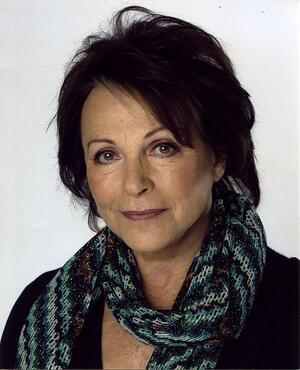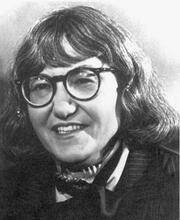Claire Bloom
Actress and writer, Claire Bloom.
Courtesy of Wikimedia Commons.
From her first film role in Charlie Chaplin’s 1952 film Limelight to her performance in 2010’s The King’s Speech, Claire Bloom is one of the most iconic and popular actresses of her generation. In 1941, her family moved from London to Florida to escape the Blitz, and Bloom began performing on radio shows and at a local hotel. After returning to London in 1943, she earned a scholarship to the Guildhall School of Music and Drama and made her London stage debut at sixteen, alongside Richard Burton in Christopher Fry’s acclaimed The Lady’s Not for Burning. She starred opposite Burton again in 1959’s Look Back in Anger and 1965’s The Spy Who Came in from the Cold. Bloom has won two BAFTA awards and was made a Commander of the British Empire.
Early Life and Family
Since her first film role in Charlie Chaplin’s Limelight literally propelled her into the limelight, Claire Bloom has been one of the most iconic and popular actresses of her generation. She was born on February 15, 1931, in the north London suburb of Finchley, the first child of Edward Bloom and Elizabeth Grew. Edward’s family name Blume was modified to Bloom by his wife at some point in the 1930s; his grandfather had immigrated to England, probably from Russia, and had apparently borrowed the name Blumenthal from a fellow passenger’s passport. Claire’s maternal grandmother Pauline, the daughter of the Chief Rabbi of Frankfurt, also came to England around 1900 from Riga together with her husband Henry, who was born in Russia and who later started a successful furniture factory in London’s East End.
Both of Claire’s parents were born in England, her father in Liverpool and her mother in Cricklewood in London. Although all four of Claire’s grandparents were Jewish, Pauline, Elizabeth’s mother, was the only member of the family who still maintained Jewish rites and traditions and always tried to bring as many members of the family together on Friday night. Her elder daughter Mary was a successful West End actress, who served as a mentor to the young Claire when she was developing an interest in the theater. Claire’s early life was disrupted both by the war and by her father’s erratic fortunes as a salesman; in the years before the outbreak of World War II, the family moved several times, from Cardiff to Bristol to Cornwall to New Milton. As a result, Claire’s schooling was somewhat haphazard. She was sent to Badminton, an elegant private girls’ school, but soon afterwards, her father’s fortunes having declined, the family (including her younger brother John, born in 1936) moved to Cornwall and Claire was sent to the local village school. They moved again to New Milton, where Claire was sent to yet another school, Fern Hill Manor. After war broke out, the family moved back to London, and Claire was subsequently sent to the country with her cousin Norma, to a school run by Bertrand Russell’s widow Dora. Progressive in policy and outlook, it encouraged nudity and did not enforce attendance at lessons.
In 1941, Edward’s brother invited Elizabeth and her children to live with them in Florida to escape the Blitz. It was not a happy period, although it was at this time that Claire first discovered her love of performing; she went to dancing school, sang on the radio, and performed regularly at a large Miami hotel. After a year, Elizabeth and the children moved to Forest Hills in New York, where Claire continued at dancing school in Manhattan and performed in her first radio play.
Early Acting Career
In 1943, the family returned to London via Lisbon, and, Edward’s fortunes for the time being having much improved, they moved into a large apartment in Curzon Street, Mayfair. Claire’s acting ambitions led her to a scholarship to the Guildhall School of Music and Drama at the age of thirteen and a year later to the Central School of Speech and Drama. After her studies, she began to act in repertory theater in productions by such illustrious directors as Peter Brook and Tyrone Guthrie. It was around this time that Edward wrote to Elizabeth from South Africa asking for a divorce so that he could marry his girlfriend Betty. For many years thereafter, Claire had no relationship with her father.
In 1952, after a grueling week of auditions and several months of waiting, Bloom won the part of the ballerina in Charlie Chaplin’s Limelight. She became close friends with both Oona, Chaplin’s wife, and his son Sydney, alongside whom she acted in the film. Limelight made her a star when it opened in the same week as she made her acclaimed debut as Juliet opposite Alan Badel as Romeo at the Old Vic. Suddenly, aged twenty-one, she was a star.
Personal Life and Later Career
In the years following this success Bloom worked with some of the greatest names in British theater. In 1955, she made Richard III with Laurence Olivier and in 1958 starred in Look Back in Anger with Richard Burton, whom she had met almost a decade earlier when they were both in Christopher Fry’s The Lady’s Not for Burning. She had had her first real love affair with Burton. Also in 1958, she starred in The Brothers Karamazov alongside Yul Brynner, with whom she also had an affair, and then accepted a role on Broadway with Rod Steiger in Rashomon in 1958. Within a year, she was pregnant by Steiger, whom she married in 1959. Their daughter, Anna Justine, who was born in February 1960, is an opera singer.
Bloom and Steiger remained in America, moving to California, where Steiger pursued a film career. They divorced in 1969 and soon afterwards Bloom married theater producer Hillard Elkins, who produced Ibsen’s A Doll’s House, with Bloom as Nora, and Hedda Gabler, with Bloom as Hedda, for his wife to star in. Later Bloom won the role of Blanche DuBois in Tennessee Williams’s A Streetcar Named Desire; all were productions that served to consolidate Bloom’s reputation as one of the finest actors of her generation.
The marriage to Elkins did not last, and in 1976 they were divorced. In financial trouble, Bloom returned to London with Anna, but on a stopover in New York on her way to Hawaii, a chance encounter brought her together with Philip Roth. This relationship was to prove the most longstanding of all, although their marriage lasted only five years, from 1990 to 1995. Bloom chronicled the breakdown of the relationship in her 1996 memoir Leaving a Doll’s House.
Bloom continued to act and won several awards for her performances, including a BAFTA for Shadowlands (1985) and an International Emmy Award for The Belle of Amherst (1987). In 2006, she starred with Billy Zane in a West End production of the play Six Dance Lessons in Six Weeks and appeared in a mini-series version of The Ten Commandments. She later appeared in numerous television roles, including two episodes of Doctor Who in 2009 and 2010. In 2010, she played Queen Mary in the Oscar- and BAFTA-award-winning film The King’s Speech. Bloom appeared as the narrator in a 2012 performance of Leonard Bernstein's Symphony No. 3, "Kaddish," with The Baltimore Symphony Orchestra. In 2013, she was appointed a Commander of the Order of the British Empire. Bloom acted in the 2018 film Miss Dalí, and in 2019 appeared in the BBC TV miniseries Summer of Rockets about a Russian Jewish inventor during the Cold War.
Billington, Michael. “Six Dance Lessons in Six Weeks, Haymarket, London.” The Guardian, December 1, 2006. https://www.theguardian.com/stage/2006/dec/01/theatre.
“Birthday Honours: Adele Joins Blackadder Stars on List.” BBC News, June 14, 2013. https://www.bbc.com/news/uk-22904807.
Kenny, Glenn. “'Miss Dalí' Review: A Disorienting Biography of Surrealist's Sister.” The New York Times, November 15, 2018. https://www.nytimes.com/2018/11/15/movies/miss-dali-review.html.
Smith, Tim. “Marin Alsop, BSO Peform Bernstein's 'Kaddish' Featuring Claire Bloom.” Baltimore Sun, June 12, 2018. https://www.baltimoresun.com/bs-mtblog-2012-09-marin_alsop_bso_peform_b….





